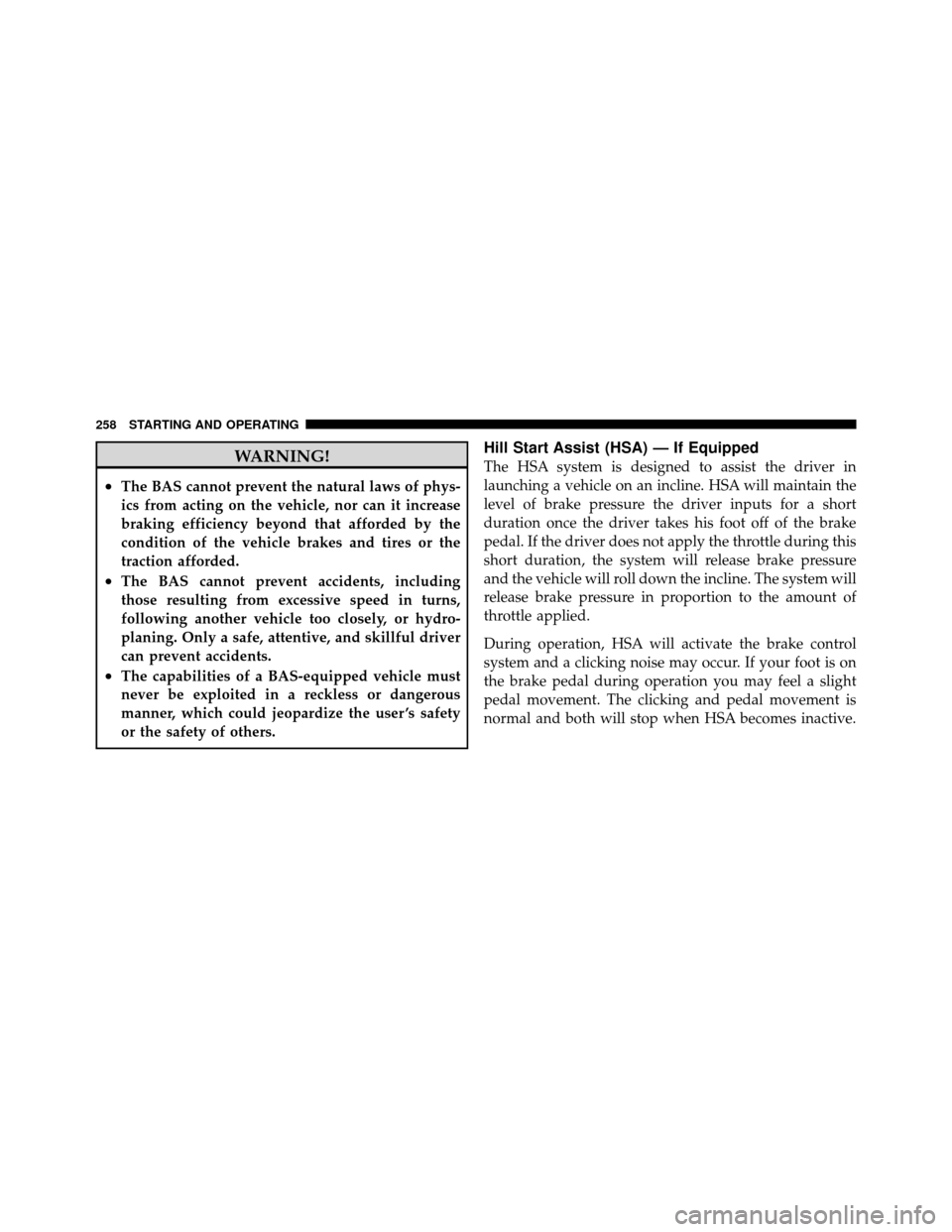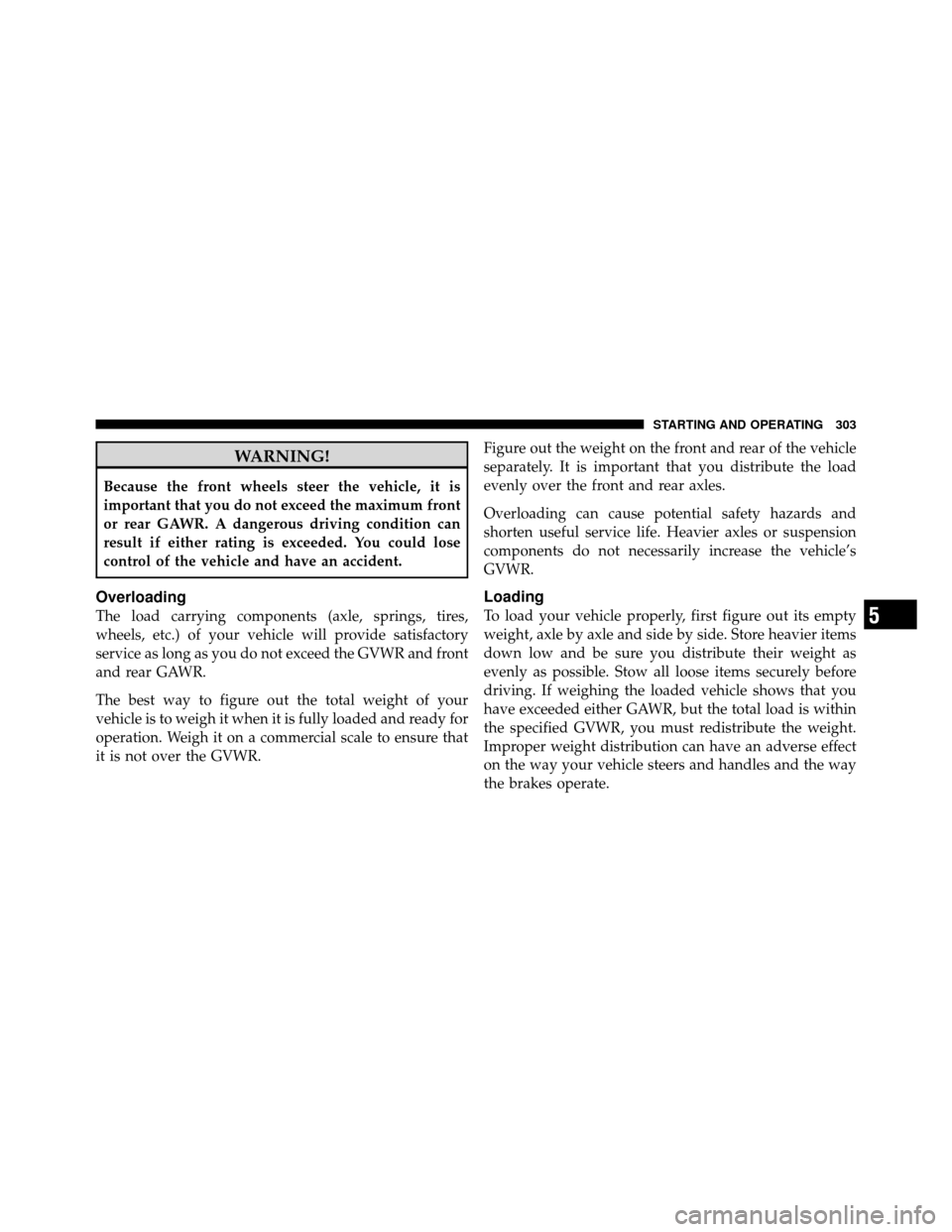Page 258 of 436

WARNING!
•The BAS cannot prevent the natural laws of phys-
ics from acting on the vehicle, nor can it increase
braking efficiency beyond that afforded by the
condition of the vehicle brakes and tires or the
traction afforded.
•The BAS cannot prevent accidents, including
those resulting from excessive speed in turns,
following another vehicle too closely, or hydro-
planing. Only a safe, attentive, and skillful driver
can prevent accidents.
•The capabilities of a BAS-equipped vehicle must
never be exploited in a reckless or dangerous
manner, which could jeopardize the user ’s safety
or the safety of others.
Hill Start Assist (HSA) — If Equipped
The HSA system is designed to assist the driver in
launching a vehicle on an incline. HSA will maintain the
level of brake pressure the driver inputs for a short
duration once the driver takes his foot off of the brake
pedal. If the driver does not apply the throttle during this
short duration, the system will release brake pressure
and the vehicle will roll down the incline. The system will
release brake pressure in proportion to the amount of
throttle applied.
During operation, HSA will activate the brake control
system and a clicking noise may occur. If your foot is on
the brake pedal during operation you may feel a slight
pedal movement. The clicking and pedal movement is
normal and both will stop when HSA becomes inactive.
258 STARTING AND OPERATING
Page 303 of 436

WARNING!
Because the front wheels steer the vehicle, it is
important that you do not exceed the maximum front
or rear GAWR. A dangerous driving condition can
result if either rating is exceeded. You could lose
control of the vehicle and have an accident.
Overloading
The load carrying components (axle, springs, tires,
wheels, etc.) of your vehicle will provide satisfactory
service as long as you do not exceed the GVWR and front
and rear GAWR.
The best way to figure out the total weight of your
vehicle is to weigh it when it is fully loaded and ready for
operation. Weigh it on a commercial scale to ensure that
it is not over the GVWR.Figure out the weight on the front and rear of the vehicle
separately. It is important that you distribute the load
evenly over the front and rear axles.
Overloading can cause potential safety hazards and
shorten useful service life. Heavier axles or suspension
components do not necessarily increase the vehicle’s
GVWR.
Loading
To load your vehicle properly, first figure out its empty
weight, axle by axle and side by side. Store heavier items
down low and be sure you distribute their weight as
evenly as possible. Stow all loose items securely before
driving. If weighing the loaded vehicle shows that you
have exceeded either GAWR, but the total load is within
the specified GVWR, you must redistribute the weight.
Improper weight distribution can have an adverse effect
on the way your vehicle steers and handles and the way
the brakes operate.5
STARTING AND OPERATING 303
Page 310 of 436

WARNING!
•Improper towing can lead to an injury accident.
Follow these guidelines to make your trailer tow-
ing as safe as possible:
•Make certain that the load is secured in the trailer
and that it will not shift during travel. When
trailering cargo that is not fully secured, dynamic
load shifts can occur that may be difficult for the
driver to control. You could lose control of your
vehicle and have an accident.
•When hauling cargo, or towing a trailer, do not
overload your vehicle or trailer. Overloading can
cause a loss of control, poor performance, or dam-
age to brakes, axle, engine, transaxle, steering,
suspension, chassis structure, or tires.(Continued)
WARNING! (Continued)
•Safety chains must always be used between your
vehicle and trailer. Always connect the chains to
the frame or hook retainers of the vehicle hitch.
Cross the chains under the trailer tongue and
allow enough slack for turning corners.
•Vehicles with trailers should not be parked on a
grade. When parking, apply the parking brake on
the tow vehicle. Put the tow vehicle automatic
transaxle in PARK. Always, block or�chock�the
trailer wheels.
•GCWR must not be exceeded.
(Continued)
310 STARTING AND OPERATING
Page 312 of 436

Towing Requirements — Trailer Brakes
•
Donot interconnect the hydraulic brake system or
vacuum system of your vehicle with that of the trailer.
This could cause inadequate braking and possible
personal injury.
•An electronically actuated trailer brake controller is
required when towing a trailer with electronically
actuated brakes. When towing a trailer equipped with
a hydraulic surge actuated brake system, an electronic
brake controller is not required.
•Trailer brakes are recommended for trailers over
1,000 lbs (450 kg) and required for trailers in excess of
2,000 lbs (907 kg).
CAUTION!
If the trailer weighs more than 1,000 lbs (450 kg)
loaded, it should have its own brakes with adequate
braking capacity. Failure to do this could lead to
accelerated brake lining wear, higher brake pedal
effort, and longer stopping distances.
WARNING!
•Do not connect trailer brakes to your vehicle’s
hydraulic brake lines. It can overload your brake
system and cause it to fail. You might not have
brakes when you need them and could have an
accident.
(Continued)
312 STARTING AND OPERATING
Page 360 of 436

•Make sure that the radiator and coolant recovery
bottle overflow hoses are not kinked or obstructed.
•Keep the front of the radiator clean. If your vehicle is
equipped with air conditioning, keep the front of the
condenser clean.
•Do not change the thermostat for Summer or Winter
operation. If replacement is ever necessary, install
ONLY the correct type thermostat. Other designs may
result in unsatisfactory cooling performance, poor gas
mileage, and increased emissions.
Brake System
In order to assure brake system performance, all brake
system components should be inspected periodically.
Refer to the “Maintenance Schedule” in Section 8 for the
proper maintenance intervals.
WARNING!
Riding the brakes can lead to brake failure and
possibly an accident. Driving with your foot resting
or riding on the brake pedal can result in abnormally
high brake temperatures, excessive lining wear, and
possible brake damage. You would not have your full
braking capacity in an emergency.
Master Cylinder - Brake Fluid Level Check
Check the fluid level in the master cylinder immediately
if the brake system warning light indicates system fail-
ure.
Check the fluid level in the master cylinder when per-
forming underhood services.
360 MAINTAINING YOUR VEHICLE
Page 375 of 436
CavityCartridge
Fuse Mini
Fuse Description
31 —10 Amp
Red —
32 30 Amp
Pink —Auto Shutdown
(ASD) Relay Feed 1
33 —10 Amp
Red Battery Feed —
Switch Bank/
Diagnostic Link
Connector/
Powertrain Control
Module (PCM)
34 30 Amp
Pink —Battery Feed —
Anti-Lock Brakes
(ABS) Module - if
equipped/
Electronic Stability
Program (ESP)
Module - If
EquippedCavity
Cartridge
Fuse Mini
Fuse Description
35 40 Amp
Green —Battery Feed —
Anti-Lock Brakes
(ABS) Module - If
Equipped/
Electronic Stability
Program (ESP)
Module - If
Equipped
7
MAINTAINING YOUR VEHICLE 375
Page 418 of 436

About Your Brakes....................... 252
ABS (Anti-Lock Brake System) .............. 254
Adding Engine Coolant (Antifreeze) .......... 356
Adding Fuel ........................... 299
Adding Washer Fluid ..................... 352
Additives, Fuel ......................... 293
Air Cleaner, Engine (Engine Air Cleaner Filter) . . . 346
Air Conditioner Maintenance ............... 348
Air Conditioning ........................ 218
Air Conditioning Controls ................. 218
Air Conditioning Filter .................229,349
Air Conditioning, Operating Tips ............ 230
Air Conditioning Refrigerant .............348,349
Air Conditioning System .............218,222,348
Air Pressure, Tires ....................... 273
Airbag .............................. 54,64
Airbag Deployment ....................... 65
Airbag Light ................... 55,62,68,83,147
Airbag Maintenance ....................... 67 Airbag, Side
........................ 57,61,64
Airbag, Window (Side Curtain) ...........58,61,64
Alarm System (Security Alarm) ............18,154
Alterations/Modifications, Vehicle ............. 7
Antenna, Satellite Radio ................... 210
Antifreeze (Engine Coolant) ...........355,356,386
Disposal ............................ 358
Anti-Lock Brake System (ABS) .............. 254
Anti-Lock Warning Light .................. 254
Anti-Theft Security Alarm (Theft Alarm) ........ 18
Appearance Care ........................ 365
Ashtray ............................... 131
Auto Down Power Windows ................ 34
Auto Unlock, Doors ....................... 31
Auto Up Power Windows ................35,128
Automatic Dimming Mirror ................. 90
Automatic Door Locks ................... 30,31
Automatic Oil Change Indicator ........152,162,390
Automatic Temperature Control (ATC) ......... 222
418 INDEX
Page 419 of 436

Automatic Transaxle..............12,235,239,362
Adding Fluid ................... 363,364,388
Filter ............................... 364
Fluid and Filter Changes ................. 364
Fluid Level Check ................... 363,364
Interlock System .................... 240,241
Reset Mode .......................... 245
Selection Of Lubricant ................... 388
Shifting ............................. 239
Special Additives ...................... 364
Autostick ............................. 246
Back-Up Lights ......................... 381
Battery ............................... 346
Gas Caution .......................... 347
Jump Starting ......................... 29
Keyless Transmitter Replacement (RKE) ....... 25
Location ............................ 346
Belts, Seat .............................. 83 Body Mechanism Lubrication
............... 350
B-Pillar Location ........................ 268
Brake Assist System ...................... 257
Brake, Parking .......................... 252
Brake System ........................... 360
Anti-Lock (ABS) ....................... 254
Fluid Check ....................... 360,388
Master Cylinder ....................... 360
Parking ............................. 252
Warning Light ........................ 148
Brakes ............................... 360
Brake/Transaxle Interlock .................. 240
Break-In Recommendations, New Vehicle ........ 81
Bulb Replacement ....................... 377
Bulbs, Light .......................... 84,377
Calibration, Compass ..................... 165
Capacities, Antifreeze (Engine Coolant) ......... 20
Capacities, Fluid ........................ 386
10
INDEX 419